
Poor customer service impairs user experience and undermines brand authority, loyalty, and profitability. Businesses often grapple with different customer service trends to avoid these unfavorable consequences. The challenge is scaling support without compromising customer-brand connection. That’s when you should outsource customer service.
Even a single negative impression can make 52% of consumers switch to competitors, which results in significant annual losses. On the other hand, companies can see a 10-15% revenue increase by improving their customer service.
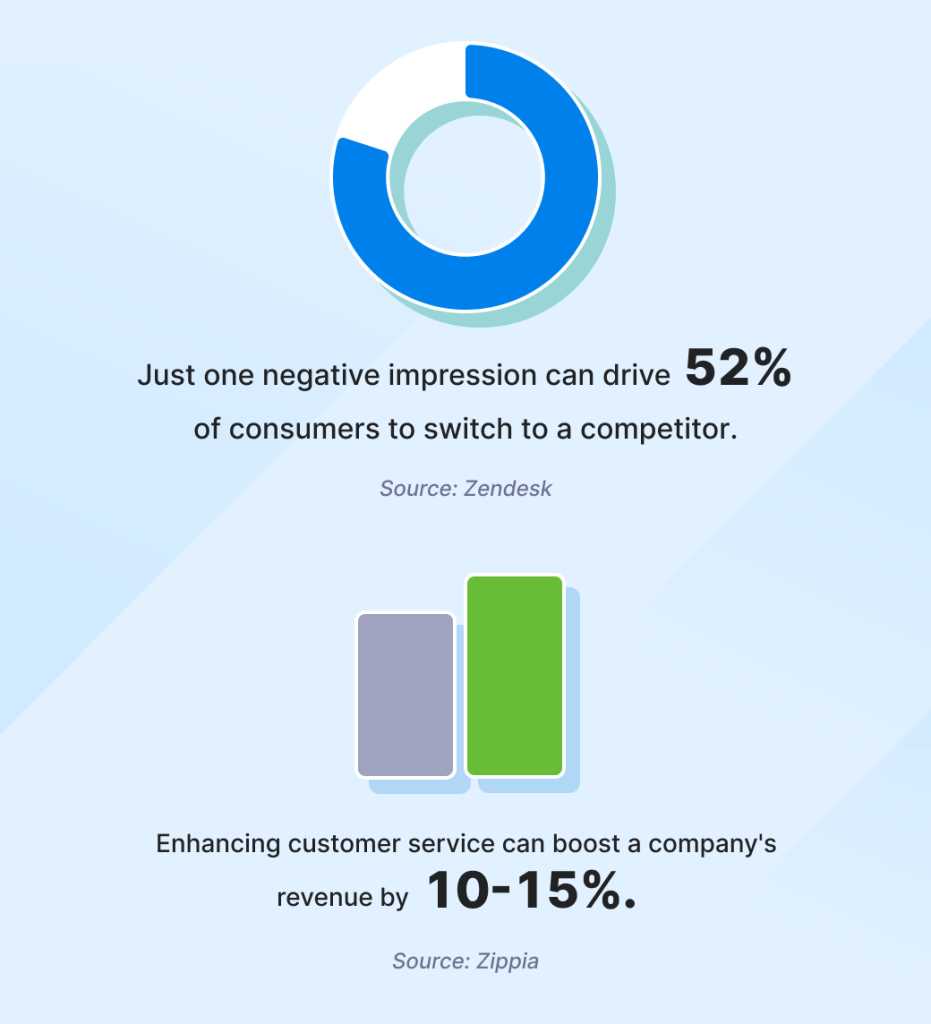
Knowing how to outsource customer service properly can be a game changer in light of these statistics. It can ensure proficient handling of customer interactions. It involves entrusting support duties to an external agency.
This guide will help you navigate the intricacies of customer service outsourcing. You’ll also find practical steps and top providers to help you outsource customer service.
Pros and cons of outsourcing customer service
If you’d like to outsource your customer service, you should know that this is a strategic decision that demands careful consideration. Weighing the potential benefits against the risks is essential. It helps you make an informed choice that aligns with your business objectives. Let’s look at the advantages and disadvantages you should take into account.
Pros of customer service outsourcing
Here are the reasons why many businesses opt to outsource customer service.
- Flexible coverage: Third-party agencies can provide customer support outside regular business hours. They even offer 24/7 service. So, businesses can meet their customers’ needs promptly.
- Global reach: Outsourcing can offer customer support in multiple languages and time zones. This leads to broadening the business’s customer service footprint.
- Cost savings: Outsourcing helps reduce expenses related to hiring, training, and infrastructure when request volumes are not constantly high. Outsourcing partner agents can also serve different customers in parallel.
- Less time managing an internal team: Outsourcing allows businesses to focus more on core operations and growth strategies. This way, it frees them from the time-intensive task of managing customer service.
- Efficient customer service management: Outsourcing partners have established processes and resources to handle complex customer requests efficiently. As a result, turnaround times decrease.
Level up support with Textmagic Point AI
Connect your knowledge base and trust it to deliver instant, accurate answers across all channels.
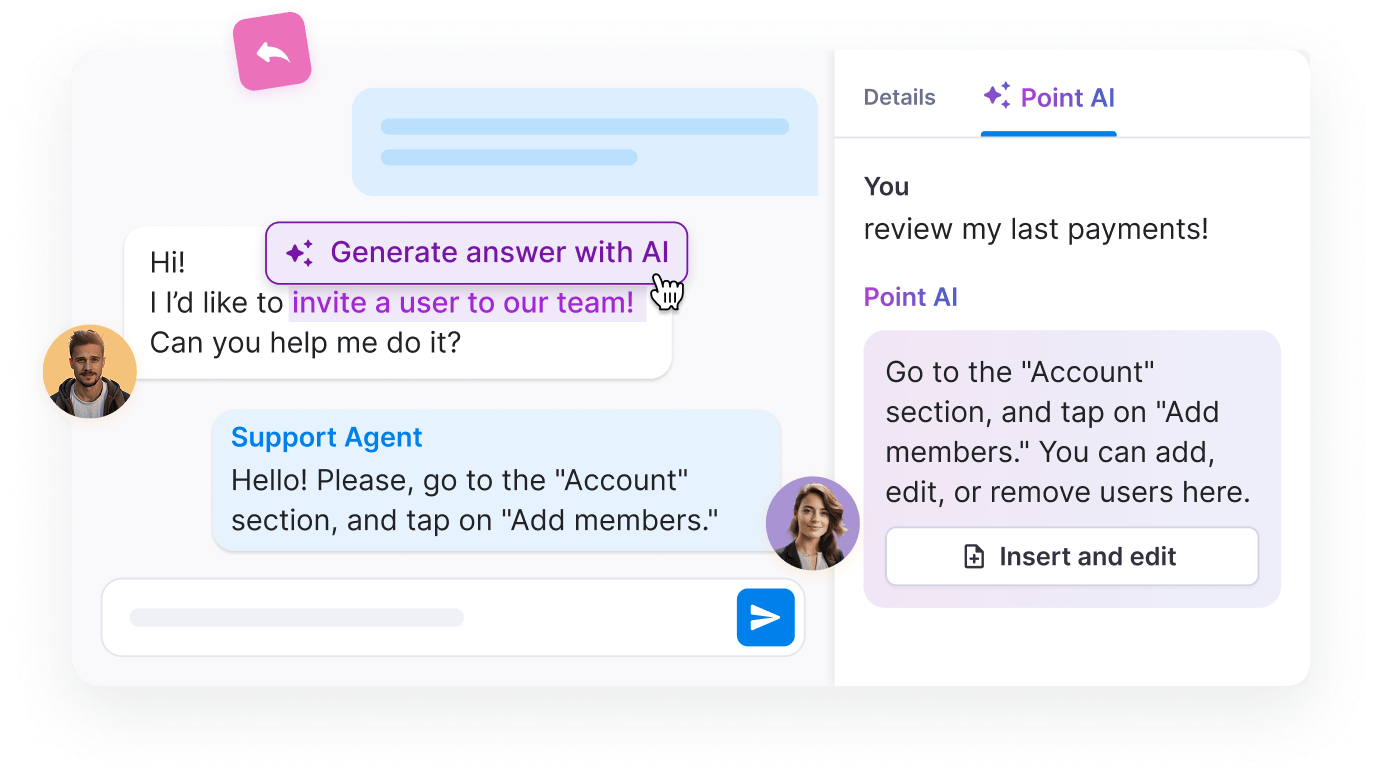
Cons of customer service outsourcing
Below you may find the downsides you should be aware of if you’re thinking to outsource customer service.
- Limited product and customer knowledge: Outsourced agents may not have an in-depth understanding of your products or customers. This could impact the quality of service provided.
- Lack of personal attention: Outsourced teams typically serve multiple clients simultaneously. So, they may not prioritize your business, potentially leading to service inconsistencies.
- Process setup and information sharing: Outsourcing requires effort in establishing processes, transferring knowledge, and maintaining communication. These tasks can be time-consuming and challenging.
- Data security concerns: Handling sensitive customer data via a third-party agency can present security risks. It can lead to data breaches, reputational damage, and financial loss.
🛡️Utilizing antivirus software like Bitdefender can help mitigate the risk of data breaches and protect against potential threats when handling sensitive customer data through a third-party agency.
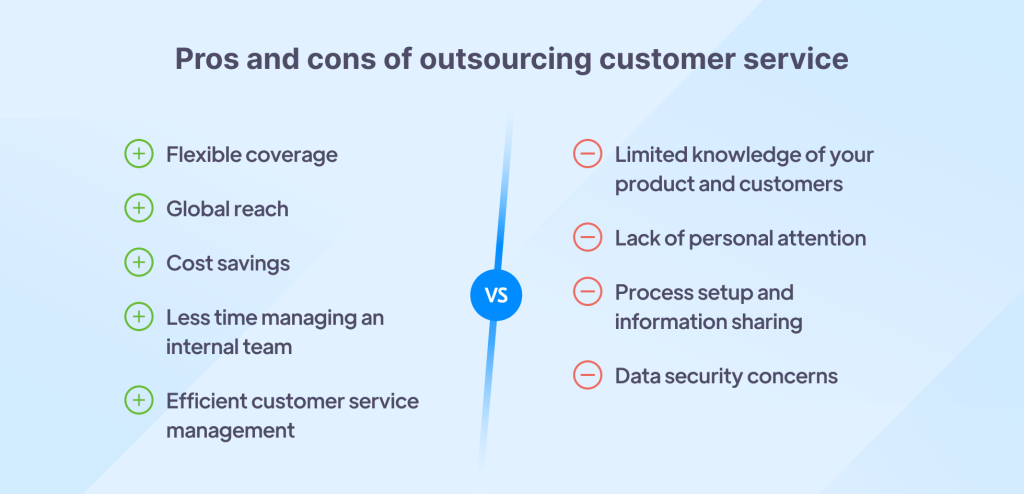
Customer support tiers
Customer support is often tiered, varying by the complexity of the issue and the corresponding staff expertise. The first tier is the first line of defense and handles common queries and issues. Some examples include:
- Password resets
- Payment-related questions
- General questions about products
The higher tiers manage more complex situations, which makes them more demanding.
💡 Outsourcing first-tier support is a strategic and beneficial step. It offers lower complexity, standardized nature, and higher volume. Assigning these straightforward tasks to an external customer support partner allows internal teams to focus on more intricate, product-specific interactions.
Eight steps to outsource customer service
Now, you might wonder how to transition to outsourcing effectively. Here is a comprehensive guide. It is organized into two pivotal segments.
- Selecting a reliable partner: This part outlines criteria to consider when identifying and assessing potential outsourcing partners.
- Onboarding and performance measurement: Once a partner is chosen, the second segment illustrates how to integrate them into your operations and track their performance.
Outsourcing is not just about delegation. It’s a strategic collaboration that requires careful planning and monitoring. Let’s dive into the steps to make this transition smooth and successful.
How to select the right outsourcing partner
Here is how to choose the best customer service outsourcing company.
1. Establish your reasons for outsourcing to identify success KPIs
Firstly, determine your motivation behind outsourcing. Are you looking to reduce costs, extend support hours, or improve response times? Establishing clear objectives will allow you to define relevant key performance indicators (KPIs) that measure the success of your outsourcing efforts.
Consider incorporating the following KPIs into your evaluation.
- Average wait time: This measures the duration customers wait before they interact with a service agent. A shorter wait time often correlates with higher customer satisfaction.
- Average handling time: Depending on the billing model, monitoring the average time taken to resolve a customer issue can indicate the efficiency of your customer service.
- First contact resolution (FCR) rate: This metric quantifies the percentage of customer issues resolved in the first interaction. A high FCR rate is usually indicative of proficient customer service.
- Customer satisfaction score (CSAT): A direct measure of customer satisfaction, this score provides insight into the overall customer experience delivered by your outsourced partner.
📝 Remember that the right KPIs depend on your specific outsourcing goals. By establishing these metrics upfront, you can set clear expectations. You can also ensure an objective assessment of your outsourcing partner’s performance.
2. Ensure the outsourcing partner covers all your needs
There are several aspects you should consider here.
2.1. Contact channels
An ideal partner should be capable of managing your key communication touchpoints. Therefore, your outsourcing partner’s choice should align with your customers’ preferred contact channels. This is key to maintaining flexibility and accessibility. Industry statistics indicate varying customer preferences regarding communication channels.
Traditional communications media still dominates the customer service landscape, with 35% and 25% of users favoring phone and email, respectively. On the other hand, top-notch newcomers like live chat are also gaining popularity, preferred by 33% of consumers.
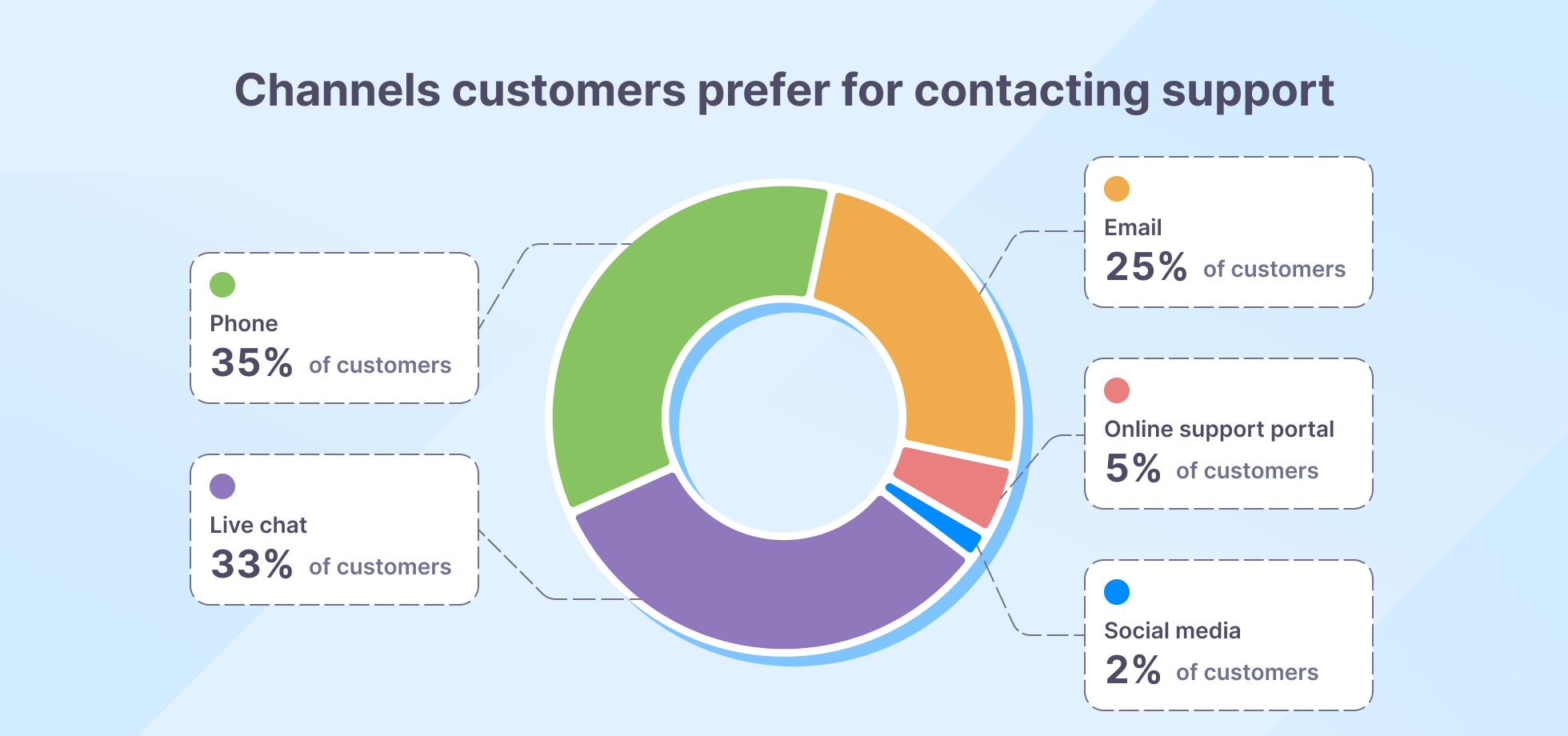
These figures underscore the need for effective communication channels and a multi-channel approach to customer service. However, it might make sense to outsource only specific customer service channels depending on your business model and customer base.
For instance, you can opt to use SMS as a customer support channel during out-of-office hours. Full-fledged text messaging platforms like Textmagic can provide an additional channel to deal with customers’ queries and issues as they text them in, even during out-of-office hours.
2.2. Time zone coverage
Given the global nature of today’s businesses, being there for your customers on time can be a great challenge. Choose an outsourcing partner that offers coverage across various time zones to optimize your customer service. Not only does this provide a round-the-clock service, but also gives you confidence to expand your company’s global reach.
🕒 Opting for a single partner able to manage multiple time zones reduces the administrative load and stress of dealing with several providers operating in different regions.
2.3. Language coverage
Language barriers create another bottleneck in your customer journey. Thus, you should select a service provider capable of effectively communicating in the languages your customers predominantly use.
🎓 Conversing fluently in users’ native language will enable the support agent to fully understand their issues and offer a precise solution.
2.4. Scalability in line with current needs
Scalability is a key concern when outsourcing your customer service. It’s crucial to engage a partner capable of adjusting to your fluctuating demands for customer support. Whether you’re facing a peak requiring rapid expansion of your support team or you need to cut it down during slower periods, your outsourcing partner should be able to adapt.
⚖️ Having a scalable partner optimizes cost-effectiveness and ensures a consistent quality of service in line with your business dynamics. They allow your customer support to evolve seamlessly with your business.
2.5. Technical compatibility and flexibility
When it comes to technical compatibility and flexibility, it’s crucial that your outsourcing partner can seamlessly integrate with your existing customer service platforms. This will ensure that you maintain comprehensive oversight of all customer communication.
Check whether their system can be integrated with yours or if their platform supports functionalities that can be integrated into your operations. Technical compatibility ensures uninterrupted customer support and smooth experiences.
2.6. Reporting
The extensive reporting capabilities of your outsourcing partner contribute to transparency. It allows you to assess their performance and keep track of customer interactions.
Check if your potential partners offer advanced reporting features like comprehensive analytics, custom real-time and historical reports, and actionable insights. Employing a full-fledged collaboration platform will enable you to stay in the know at all times and on all channels. See which reporting option your potential partner offers:
- The outsourcing partner uses your customer service platform, which already provides all necessary reporting
- The outsourcing partner uses their platform but is integrated with your platform
- The outsourcing partner only uses their platform (when customer service is fully outsourced by smaller companies that prefer not to have in-house customer service at all)
Usually, the first approach is better because you have better transparency, and both the in-house and outsourced customer support teams utilize similar reports.
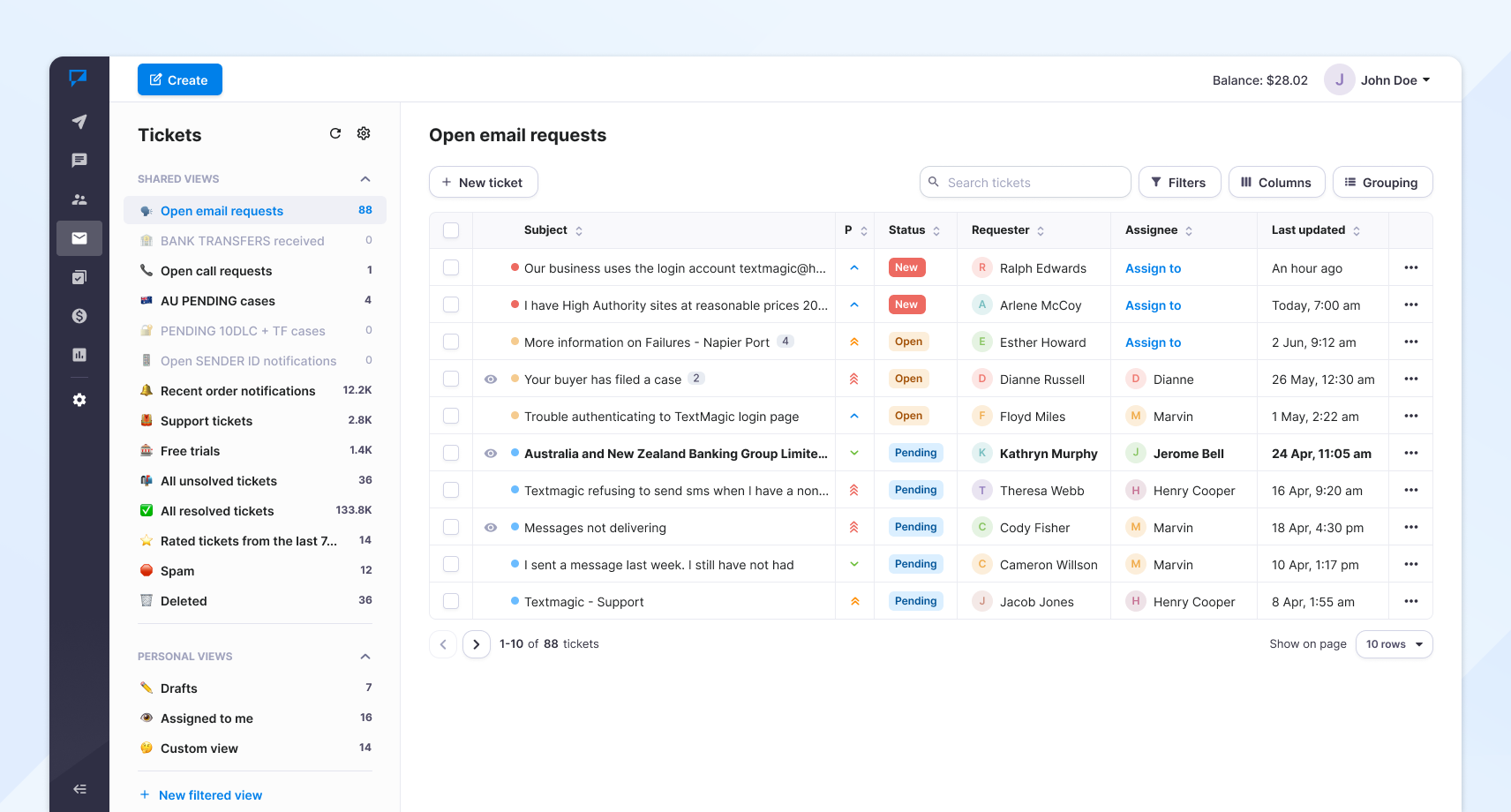
📝 Consistently maintaining extensive reporting will empower you to make data-driven decisions, deliver superior customer support, and anticipate customer needs more accurately.
3. Evaluate your outsourcing partner’s service quality
In general, providers to whom businesses outsource customer service have knowledgeable agents who have worked in different support roles and can ensure the quality of the service provided. To optimize the outcome of your outsourcing partnership, it’s essential to evaluate the potential partner’s support representatives meticulously.
They should have a proven ability to manage a range of scenarios, aligning with your specific requirements. Here are some factors to consider:
- Check the ability of your potential partner to handle challenging clients and in-depth issue discussions.
- Look at your candidates’ track record and identify their capacity to process high-volume queries.
- Seek partnerships with teams that demonstrate expertise in your niche, capable of addressing technical issues or escalation requests.
- Above all, ensure their agents possess quick adaptability, rapid learning, and engagement. These characteristics are critical for them to mimic your brand’s tone and voice.
✍️ This systematic evaluation allows you to secure a fully equipped partner to uphold and enhance your service standards.
4. Onshore vs. offshore support
Choosing between onshore and offshore models can be challenging. It significantly impacts cost, quality, communication, and overall customer experience.
Offshore outsourcing refers to delegating customer service to a provider in a foreign country. Usually, these countries have considerably lower labor costs. It is often favored due to the cost advantages it offers.
Different global regions have varying labor costs reflected in the pricing offered by outsourcing providers. For instance:
- The per-hour cost in India ranges between $6 and $10
- In Asia/Philippines it ranges between $8 and $14
- In North America, it can be between $25 and $65 per hour per representative
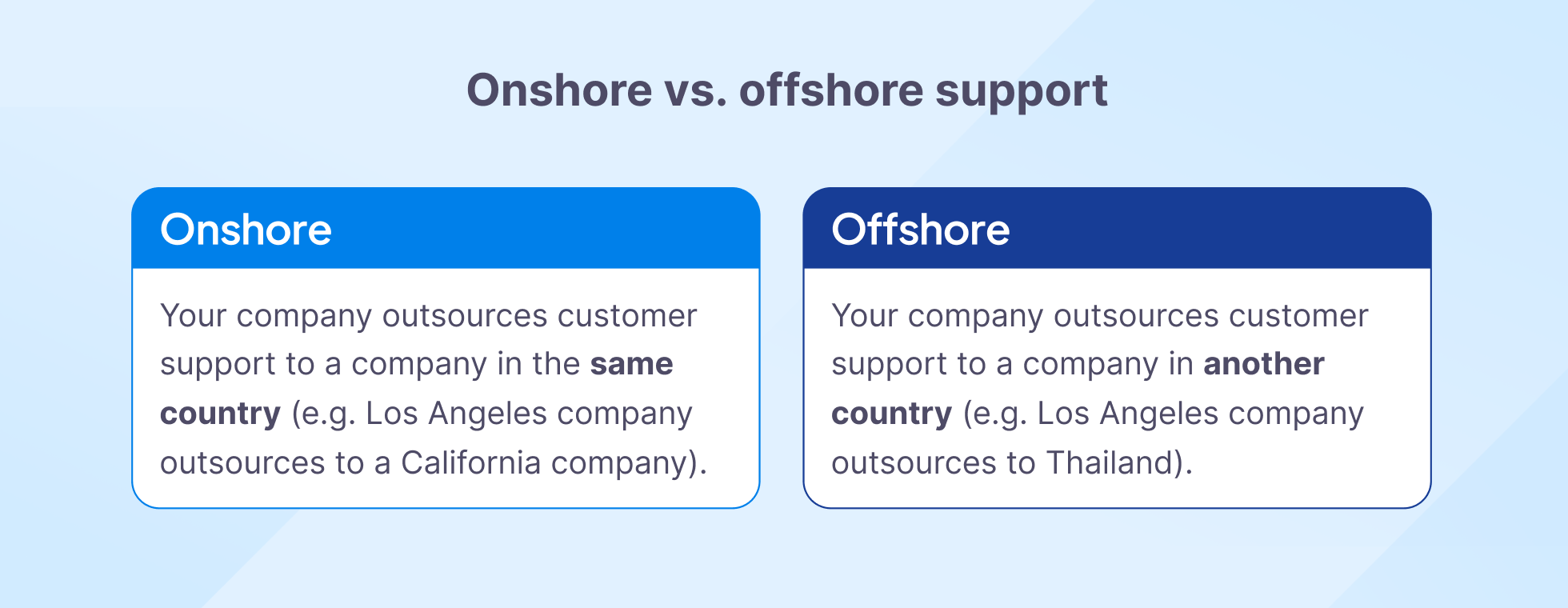
While outsourcing can offer substantial cost savings and round-the-clock service due to time zone differences, it may pose challenges in communication, cultural understanding, and quality control. Opting for the lowest possible rates should not come at the expense of customer service quality.
In contrast, onshore or domestic outsourcing involves partnering with a service provider located within the same country. This model typically promises better communication, cultural affinity, and superior control over quality. However, it often comes with higher costs due to the prevailing wage levels and operating costs in developed countries.
Both onshore and offshore outsourcing have their advantages and limitations. The choice depends on each company’s unique needs, budget, and strategic goals. Here is a side-by-side comparison of these two strategies:
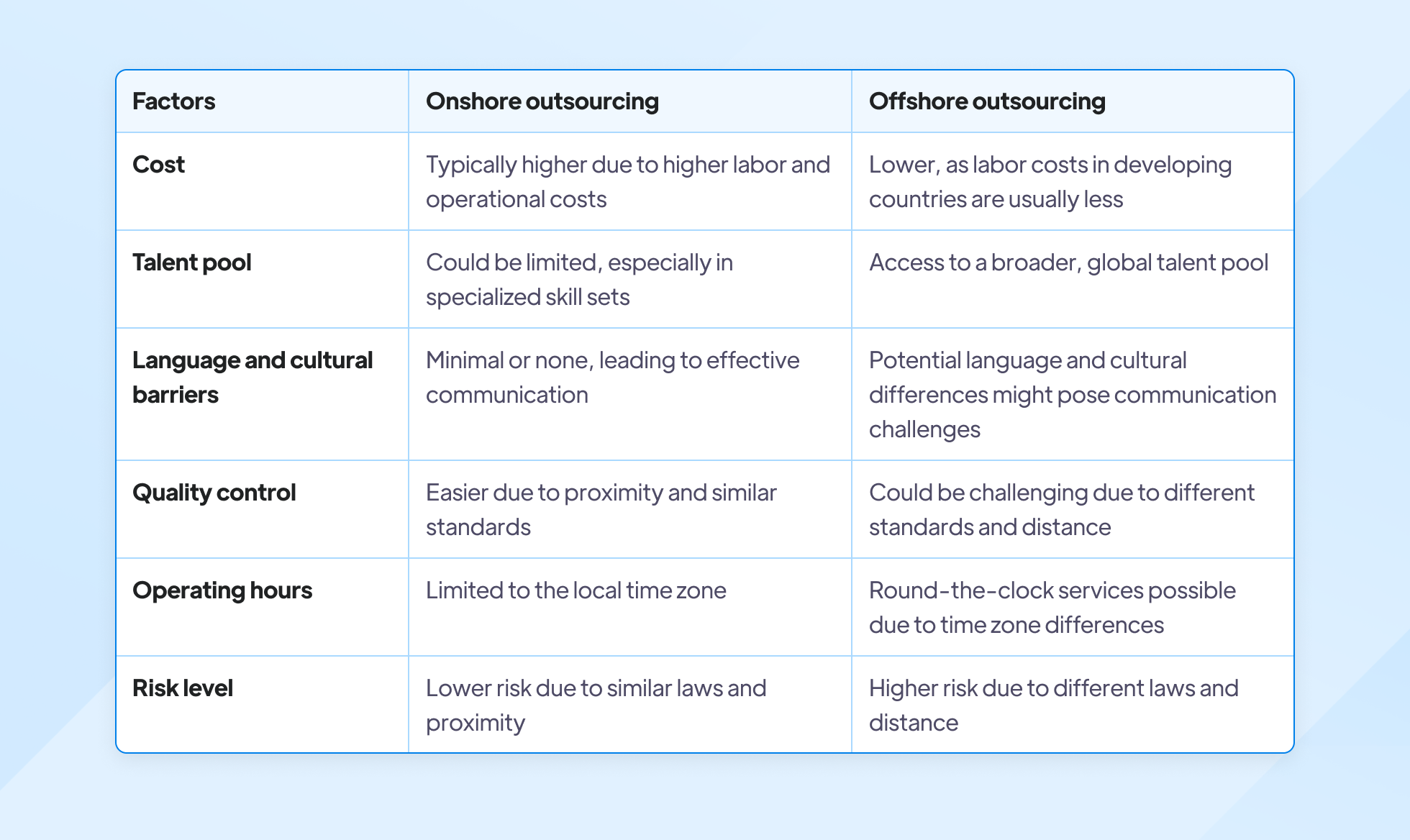
🏷️ Whether you choose offshore or onshore support, it’s essential to consider the pricing plans. Flexible pricing ensures outstanding customer service at acceptable prices. Outsourcing to lower-cost regions doesn’t inherently mean compromising service quality, provided the outsourcing is done effectively and strategically.
5. Choose your pricing model
When opting for outsourcing, understanding various pricing models is critical as it directly affects your business’s operational cost and overall budget. You can consider three primary pricing models, each with distinct advantages and disadvantages.
Full-time employee (FTE) model
In this model, you pay a fixed cost for a full-time employee hired through the outsourcing company. The advantage is its consistency and stability, as your support staff remains the same. However, it can be less flexible when your support needs fluctuate.
Pay per case model
This model is advantageous if your customer support volume is unpredictable. You only pay for each case handled, allowing flexibility and cost savings during low-volume periods. However, if support queries spike unexpectedly, costs can quickly add up.
Pay per time spent model
Here, you pay for the actual time spent on customer service by the outsourcing company. This model is ideal for complex support cases requiring longer resolution times. While it ensures you only pay for what you need, tracking and verifying time can be challenging.
💰 A transparent pricing structure is essential to avoid hidden costs. Find a pricing model that fits your business needs and customer service objectives. Discuss with potential outsourcing partners to understand their pricing structures and negotiate a model that suits your business best.
How to succeed with your outsourcing partner
This is how you ensure a successful collaboration with your chosen customer service outsourcing company.
6. Set up the right processes for outsourcing your support
Seamless support outsourcing begins with establishing robust processes. They facilitate efficient information flow, accurate forecasting, quality assurance, and feedback loop mechanisms.
A system for regular information updates
This is critical to keep your partner informed about product changes. This could involve regular briefs, access to a shared information hub, or automated updates on product modifications. This way, your outsourcing partner can offer relevant and current responses and solutions.
Forecast call and ticket volumes
This is crucial for efficient resource allocation, especially when outsourcing. Outsourcing partners rely on these forecasts to meet KPIs and plan their resources. Discrepancies between forecasted and actual volumes may lead to penalties. This is particularly relevant when high volumes are anticipated but requests are scarce.
Quality assurance
Quality assurance processes should be in place to maintain service standards, which ties in with setting up an effective feedback loop. This process is vital to ensure valuable customer insights from the outsourced team reach your product team for necessary actions.
A clear escalation process
Another critical process is establishing a clear escalation process. It outlines the rules for escalating issues from the outsourced team to your in-house staff. It is particularly important in complex cases that frontline agents can’t resolve.
An automated ticketing system
Given the demand for faster responses, an efficient, automated system ensures tickets reach the correct personnel promptly. For this purpose, businesses must set clear escalation rules to avoid miscommunication. An efficient escalation process must also include close monitoring of issue resolution and timely customer updates.
Employing the right ticket escalation tool supports the escalation process across different channels. The customer service platform allows for internal collaboration within the tool and empowers customers to report issues via their preferred platform.
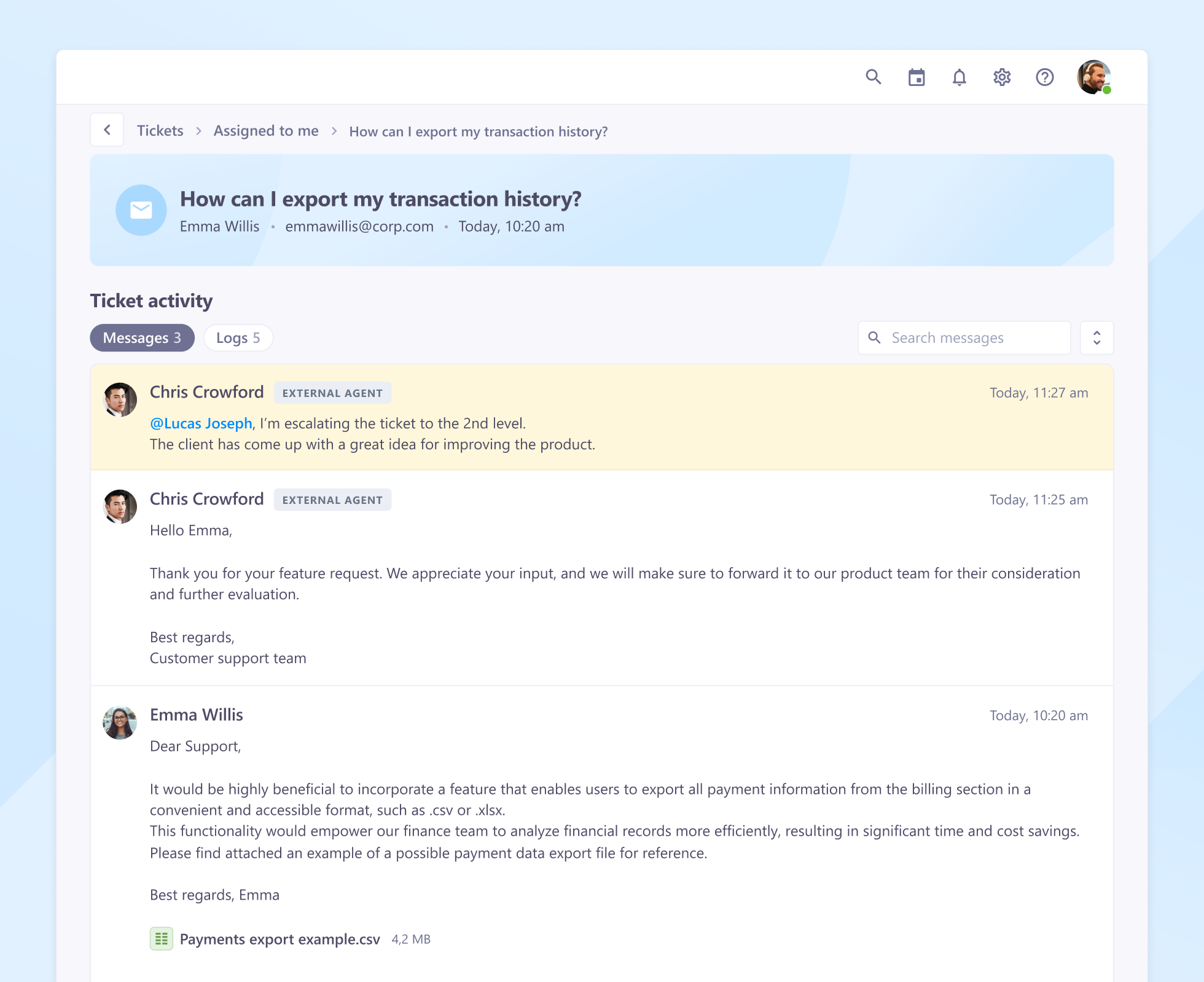
🚀 The support platform you employ should feature permission management, providing better control over the information shared. It will enable you to ensure individual agents can share only the relevant information with the team. Textmagic can be of big help here, as it provides vital features for team collaboration and information delivery.
7. Provide brand and tone guidelines to your partners
When onboarding an outsourcing partner for support services, it’s crucial to share your brand’s tone and style guidelines. This essential documentation enables your partners to communicate with your customers in a manner consistent with your brand’s voice. It provides a consistent customer experience and maintains your brand’s identity.
In addition, it’s vital to equip the customer support agents with profound knowledge and understanding of your products. This is where comprehensive and engaging product training steps in.
Blend conventional methods like presentations and manuals with hands-on activities like test accounts and simulations. Give your outsourcing partner access to knowledge databases and forums to find the latest information. Case studies, role-playing exercises, and tools like ChatGPT can help you replicate real-life customer scenarios.
8. Measure the success of your outsourcing strategy
A crucial component of your outsourcing success is the structured, systematic evaluation of the selected key performance indicators (KPIs). This post-implementation analysis helps validate whether your partner consistently delivers the quality you envisage.
Incorporate a mix of feedback mechanisms such as surveys and direct customer feedback.
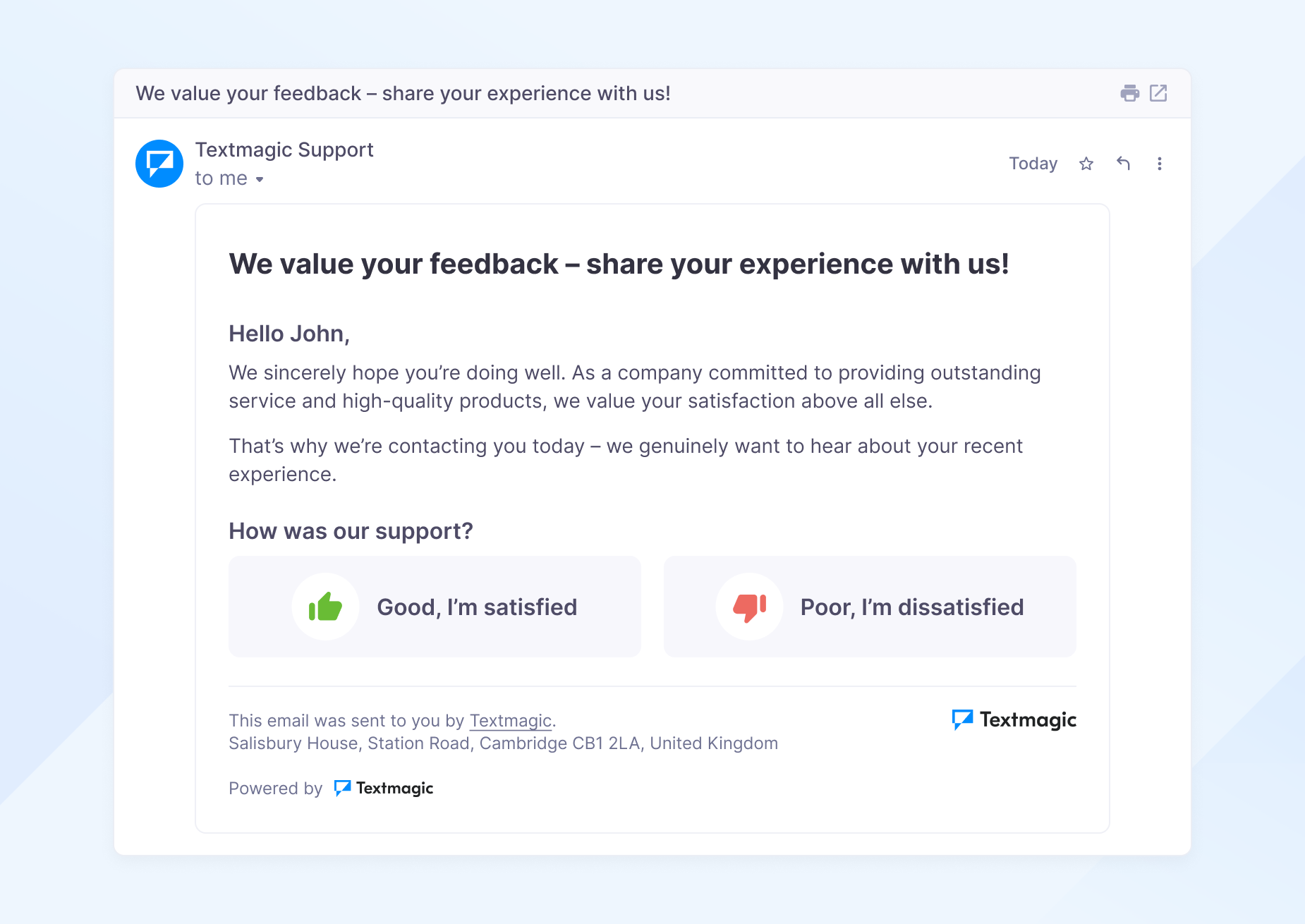
With a dedicated customer engagement platform like Textmagic, you can easily gather customer experience feedback. If you’d like to ask them for feedback via email, do check our email survey templates to come up with appropriate questions to include.
📈 Note that KPIs are not just figures to be reached. They are actionable insights that can drive continuous improvement. Regularly assess and refine your outsourcing strategy based on these metrics.
Three best outsourcing companies
When developing an outsourcing strategy, deciding to engage with a single partner for multiple markets or multiple partners for each region is crucial. Often, aligning with an outsourcing partner capable of effectively servicing all target markets is beneficial. Fewer partners mean reduced administrative load and less time and resources spent.
However, this choice must align with your organization’s strategic objectives, operational requirements, and the specific dynamics of each market. The capabilities of potential partners across all target regions should be thoroughly assessed. A single-partner approach simplifies operations. It also ensures consistent standards.
In this context, we have handpicked three best customer service outsourcing companies. They offer exceptional customer service outsourcing services. Also, they provide global outreach and ensure a seamless customer experience for businesses across regions.
Helpware
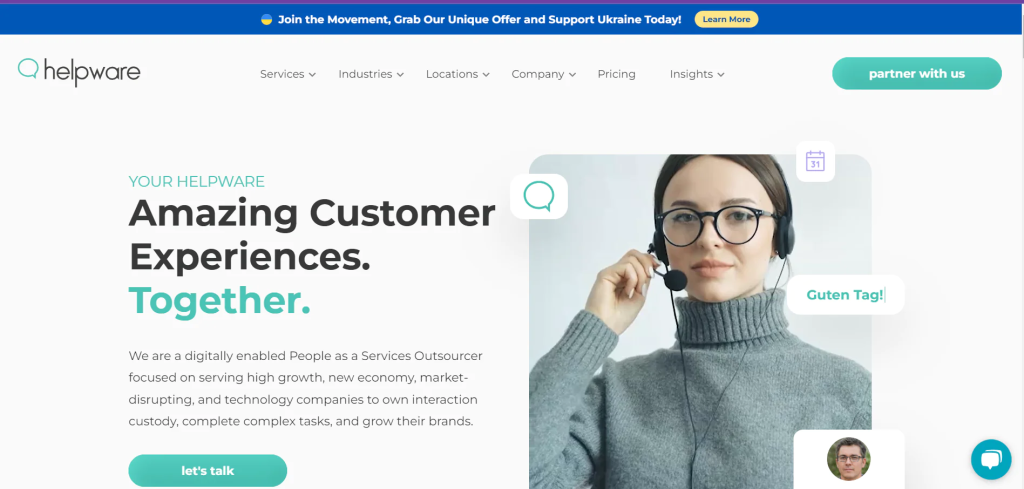
Image source: helpware.com
Helpware has made a significant mark in customer service outsourcing since its establishment in 2015. It’s headquartered in Louisville, Kentucky. The company has several branches across the US, including Kentucky, Virginia, and California. Also, team members work from various home locations nationwide.
Helpware extends its global footprint across Mexico, Germany, Ukraine, the Philippines, Poland, Albania, Puerto Rico, and Uganda. Their extensive service list includes omnichannel customer support, technical & IT support, content moderation, and more.
Dedicated agents are trained in-house and are provided with essential equipment. This results in instant productivity boosts for businesses. Some of their clients include Microsoft, Google, and Cisco.
Triniter

Image source: triniter.com
Triniter is a US-based customer service outsourcing company that offers a wide range of services. Their team delivers multichannel support in over 30 languages, covering SMS, phone, email, social media, and application platforms. Their agents are chosen for their expertise and extensive experience in their fields.
Aside from general customer support, Triniter stands out with its technical support. They have a team with IT and tech backgrounds. The company also emphasizes customer success. It assigns dedicated managers to prioritize growth and meaningful customer interactions.
With a 98.7% client retention rate and a strong 24/7 support system, Triniter has established itself as a reliable and top-performing customer service outsourcing company in the North American market, serving big clients like IBM, PayPal, and Nike.
Teleperformance

As a recognized global leader in the business process outsourcing (BPO) industry, Teleperformance brings over 40 years of experience. With more than 410,000 employees worldwide, the company offers services in over 170 countries, in 300+ languages and dialects.
Teleperformance specializes in providing comprehensive customer support, including front-office and back-office services. They offer business optimization strategies, finance and accounting, collections, and technical support. This way, the company ensures a holistic solution for their clients.
Their expertise extends to omnichannel solutions, enabling seamless interaction across various customer touchpoints. Teleperformance leverages advanced digital technologies and data analytics. This helps them simplify, accelerate, and secure customer interactions.
Teleperformance features a wide geographical footprint and broad linguistic capabilities. They make it an ideal outsourcing partner for companies targeting global markets. This has proven their dedication to continuous innovation and superior care to clients like Samsung, Santander Bank, and Grubhub.
Ready to outsource your customer service?
Outsourcing your customer service brings significant benefits. These include cost savings, flexibility, and access to expert knowledge.
Note that it’s vital to consider your choice of an outsourcing partner carefully. For this purpose, you should assess their services, technical proficiency, and understanding of your target markets.
Related articles
Maximizing SMS marketing impact with Unified Communications as a Service (UCaaS)
SMS messaging has long been a top marketing strategy...
16 Key metrics for measuring and improving customer engagement
Customer engagement metrics assess the emotional con...
Welcome emails done right: 15 Templates for every occasion
In business, much like in personal encounters, the i...
Scam text message examples and how to protect yourself from SMS phishing
Text message scams, also known as SMS scams or text ...
How to integrate Textmagic Tasks into your daily work routine
Teams can sometimes struggle to remain productive an...




